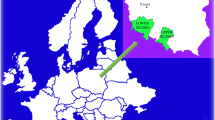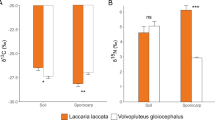Abstract
A study of a sample of Xerocomus subtomentosus revealed that the fruiting body behaved as an accumulating biosystem with respect to Rb (BF = 36), K and Ag (BF = 5.0 for both), and, to a lesser extent, Mg, Cu, Zn, and Se (BF = 1.7–3.1). A Xerocomus mushroom has not shown to be a good accumulator of toxic As (BF = 0.64), Cd (BF = 0.65), and Pb and Cr (BF < 0.1 for both) from the soil. Within-mushroom distribution of the trace elements showed very high mobility of Ag (TF = 54) and As (TF = 16); moderate mobility of K, Ti, Pb, and Rb (TF = 2.1–3.1); and low mobility to immobility of other elements. A mushroom preferentially intakes isotopically heavy Mg (Δ26Mgstipe-soil = 0.22‰) and Zn (Δ66Znstipe-soil = 0.68‰), and isotopically light Cu (Δ65Custipe-soil = − 1.04‰). The fruiting body has shown insignificant but measurable within-mushroom isotope fractionation with the higher parts of the fruiting body accumulating isotopically lighter Cu (Δ65Cucap-stipe = − 0.06‰), Zn (Δ66Zncap-stipe = − 0.18‰), and Mg (Δ26Mgcap-stipe = − 0.31‰). Such a behavior is overall similar to that displayed by the higher plants.
Similar content being viewed by others
Data availability
The datasets used and analyzed during the current study are available from the corresponding author on reasonable request.
References
Arnold T, Markovic T, Kirk GJD, Schönbächler M, Rechkämper M, Zhao FJ, Weiss DJ (2015) Iron and zinc isotope fractioantion during uptake and translocation in rice (Oryza sativa) grown in oxic and unoxic soils. Comptes Rendus Geosci 347:397–404
Bolou-Bi EB, Pozswa A, Leyval C, Vigier N (2010) Experimental determination of magnesium isotope fractionation during higher plant growth. Geochim Cosmochim Acta 74:2523–2537
Bolou-Bi EB, Vigier N, Pozswa A, Boudot J-P, Dambrine E (2012) Effects of biochemical processes on magnesium isotope variations in a forested catchment in the Vosges Mountains (France). Geochim Cosmochim Acta 87:341–355
Borovicka J, Brauer S, Sacky J, Kamenik J, Goessler W, Trubac J, Strnad L, Rohovec J, Leonhardt T, Kotrba P (2018) Speciation analysis of elements accumulated in Cystoderma carcharias from clean and smelter-polluted sites. Sci Total Environ 648:1570–1581
Brenot A, Cloquet C, Vigier N, Carignan J, France-Lanord C (2008) Magnesium isotope systematics of the lithologically varied Moselle river basin, France. Geochim Cosmochim Acta 72:5070–5082
Bullen TD (2014) Metal stable isotopes in weathering and hydrology. Treatise Geochem (Second Edition) 7:329–359
Busuioc G, Elekes CC, Stihi C, Iordache S, Ciulei SC (2011) The bioaccumulation and translocation of Fe, Zn, and Cu in species of mushrooms from Russula genus. Environ Sci Pollut Res 18:890–896
Chen S, Liu Y, Hu J, Zhang Z, Hou Z, Huang F, Yu H (2016) Zinc isotopic composition of NIST SRM 683 and whole-rock reference materials. Geostand Geoanal Res 40:417–432
Cheng Z, Zhang Z, Hou T, Santosh M, Chen L, Ke S, Xu L (2017) Decoupling of Mg-C and Sr-Nd-O isotopes traces the role of recycled carbon in magnesiocarbonatites from the Tarim Large Igneous Province. Geochim Cosmochim Acta 202:159–178
Fahad ZA, Bolou-Bi EB, Köhler SJ, Finlay RD, Mahmood S (2016) Fractionation and assimilation of Mg isotopes by fungi is species dependant. Environ Microbiol Reps 8:956–965
Galy A, Yoffe O, Janney PE, Williams RW, Cloquet C, Alard O, Halicz L, Wadhwa M, Hutcheon ID, Ramon E, Carihnan J (2003) Magnesium isotope heterogeneity of the isotopic standard SRM 980 and new reference materials for magnesium isotope ratio measurements. J Anal Atom Spectrom 18:1352–1356
Kalac P (2009) Chemical composition and nutritional value of European species of wild growing mushrooms: a review. Food Chem 113:9–16
Kalac P, Svoboda L (2000) A review of trace element concentrations in edible mushrooms. Food Chem 69:273–281
Kojta AK, Gucia M, Krasinska G, Saba M, Norom IC, Falandyzs J (2016) Mineral constituents of edible parasol (Macrolepiota procera) mushrooms and the underlying substrate from upland regions of Poland: bioconcentration potencial, intake benefits, and toxicological risk. Pol J Environ Stud 25:1–16
Kram P, Curik J, Veselovsky F, Myska O, Hruska J, Stedra V, Jarchovsky T, Buss HT, Chuman T (2017) Hydrochemical fluxes and bedrock chemistry in three contrasting catchments underlain by felsic, mafic and ultramafic rocks. Procedia Earth Planet Sci 17:538–541
Kribek B, Mikova J, Knesl I, Mihaljevic M, Sykorova I (2020) Uptake of trace elements and isotope fractionation of Cu and Zn by birch (Betula pendula) growing on mineralized coal waste pile. App Geochem 122:104741
Landweert R, Hoffland E, Finlay RD, Kuyper TW, van Breemen N (2001) Linking plants to rocks: ectomycorrhizal fungi mobilized nutrients from minerals. Trends Ecol Evol 16:248–254
Little SH, Vance D, McManus JF, Severmann S, Lyons TW (2017) Copper isotope signatures in modern marine sediments. Geochim Cosmochim Acta 212:253–273
Mallikarjuna SE, Ranjini A, Haware DJ, Viyaialaksmi MR, Shashirekha MN, Rajarathnam S (2013) Mineral composition of four edible mushrooms. J Chem 2013:1–5
Moeller K, Schoenberg R, Pedersen R-B, Weiss D, Dong S (2012) Calibration of new certified reference materials ERM-AE633 and ERM-AE647 for copper and IRMM-3702 for zinc isotope amount ratio determination. Geostand Geoanal Res 36:177–199
Moynier F, Pichat S, Pons M-L, Fike D, Balter V, Albaréde F (2009) Isotopic fractionation and transport mechanisms of Zn in plants. Chem Geol 267:125–130
Novak M, Sipkova A, Chrastny V, Stepanova M, Voldrichova P, Veselovsky F, Prechova E, Blaha V, Curik J, Farkas J, Erbanova L, Bohdalkova L, Pasava J, Mikova J, Komarek A, Krachler M (2016) Cu-Zn isotope constraints on the provenance of air pollution in Central Europe: Using soluble and insoluble particles in snow and rime. Environ Pollut 218:1135–1146
Novak M, Farkas J, Kram P, Hruska J, Stepanova M, Veselovsky F, Curik J, Andronikov AV, Sebek O, Simecek M, Fottova D, Bohdalkova L, Prechova E, Koubova M, Vitkova H (2020) Controls on δ26Mg variability in three Central European headwater catchments characterized by contrasting bedrock chemistry and contrasting inputs of atmospheric pollutants. PLoS ONE 15:e0242915. https://doi.org/10.1371/journal.pone.0242915
Ryan BM, Kirby JK, Degryse F, Harris H, McLaughlin MJ, Scheiderich K (2013) Copper speciation and isotopic fractionation in plants: uptake and translocation mechanisms. New Phytol 199:367–378
Shalev N, Farkas J, Fietzke J, Novak M, Schuessler JA, Pogge von Strandmann PAE, Torber PB (2018) Mg isotope interlaboratory comparison of reference materials from earth-surface low-temperature environments. Geostand Geoanal Res 42:205–221
Sossi PA, Halverson GP, Nebel O, Eggins SM (2015) Combined separation of Cu, Fe and Zn from rock matrices and improved analytical protocols for stable isotope determination. Geostand Geoanal Res 39:129–149
Stedra V, Kram P, Farkas J (2015) Petrology and whole-rock geochemistry of metabasites from borehole cores in the Na Zelenem and Pluhuv Bor catchments in the Slavkov Forest, western Bohemia. Czech geological Survey, Zpravy o geologickich vyzkumech v roce 2014/D – Mineralogie, petrologie a geochimie:103–108 (in Czech)
Svoboda L, Chrastny V (2008) Levels of eight trace elements in edible mushrooms from a rural area. Food Addit Contam Part A Chem Anal Control Expo Risk Assess 25:51–58
Uhlig D, Schuessler JA, Bouchez J, Dixon JL, von Blankenburg F (2017) Quantifying nutrient uptake as driver of rock weathering in forest ecosystems by magnesium stable isotopes. Biogeoscience 14:3111–3128
Viers J, Nonell OP, Gelabert A, Sonke JE, Freydier R, Gainville R, Dupre B (2007) Evidence of Zn isotopic fractionation in a soil-plant system of a pristine tropical watershed (Nsimi, Cameroon). Chem Geol 239:124–137
Voldrichova P, Chrastny V, Sipkova A, Farkas J, Novak M, Stepanova M, Krachler M, Veselovsky F, Blaha V, Prechova E, Komarek A, Bohdalkova L, Curik J, Mikova J, Erbanova L, Pacherova P (2014) Zinc isotope systematics in snow and ice accretions in Central European mountains. Chem Geol 388:130–141
Weinstein C, Moynier F, Wang K, Paniello R, Foriel J, Catalano J (2011) Cu isotopic fractionation in plants. Chem Geol 286:266–271
Weiss DJ, Mason TFD, Zhao FJ, Kirk GJD, Coles BJ, Horstwood MSA (2005) Isotopic discrimination of zinc in higher plants. New Phytol 165:703–710
Wiggenhauser M, Bigalke M, Imseng M, Keller A, Archer C, Wilcke W, Frossard E (2018) Zinc isotope fractionation during grain filling of wheat and a comparison of zinc and cadmium isotope ratios in identical soil-plant system. New Phytol 219:195–205
Zhong Y, Chen L-H, Wang X-J, Zhang G-L, Xie L-W, Zeng G (2017) Magnesium isotopic variation of oceanic island basalts generated by partial melting and crustal recycling. Earth Planet Sci Lett 463:127–135
Acknowledgements
An anonymous reviewer is thanked for the invaluable comments and suggestions. This study is a contribution to the Research Project 311040 which is a part of the Strategic Research Plan of the Czech Geological Survey (DKRVO/CGS 2018-2022).
Funding
Funding for this work was provided by the Czech Geological Survey (internal project 311040 to AVA).
Author information
Authors and Affiliations
Contributions
Alexandre V. Andronikov: conceptualization, investigation, and writing—original draft; Irina E. Andronikova: investigation and writing—original draft; Ondrej Sebek: investigation.
Corresponding author
Ethics declarations
Ethics approval and consent to participate
Not applicable.
Consent for publication
Not applicable.
Competing interests
The authors declare no competing interests.
Additional information
Responsible Editor: Philippe Garrigues
Publisher's note
Springer Nature remains neutral with regard to jurisdictional claims in published maps and institutional affiliations.
Rights and permissions
About this article
Cite this article
Andronikov, A.V., Andronikova, I.E. & Sebek, O. First data on isotope and trace element compositions of a Xerocomus subtomentosus mushroom sample from western Czech Republic. Environ Sci Pollut Res 29, 9369–9374 (2022). https://doi.org/10.1007/s11356-021-17960-y
Received:
Accepted:
Published:
Issue Date:
DOI: https://doi.org/10.1007/s11356-021-17960-y




